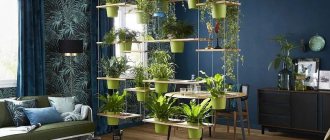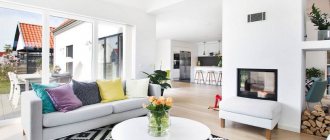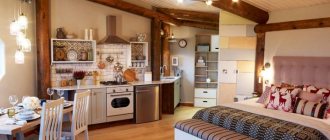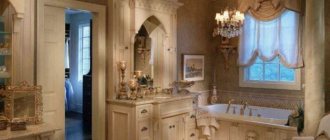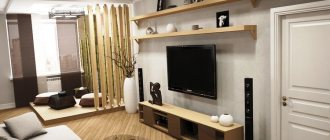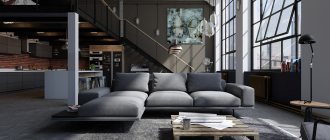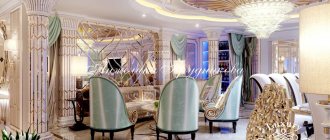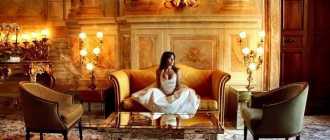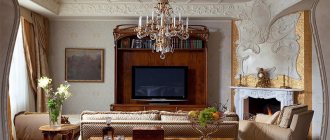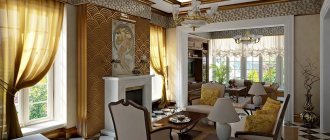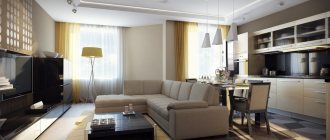Scandinavian style is one of the most recognizable trends in interior design. What exactly reflects the essence of Scandinavian style? We will analyze exactly how it differs and what is the reason for its continued popularity, and also present many interesting interiors.
In recent years, the term "Scandinavian style" has conjured up images of unpainted wooden tables and chairs covered in plain fabrics. And there is, of course, a place for this kind of furniture in many homes. But interesting and valuable Scandinavian furniture is Swedish furniture.
History and philosophy of style
The north of Europe is the territory of ancient Germans, Vikings and berserkers, furious, unpretentious “sea wolves” and pioneers. Surprisingly, the fierce tribes “grew” into peace-loving peoples who gave the world tales from trolls, brave polar explorers, 57 Nobel laureates... And the Scandinavian style in interior design is one of the most beloved in the world.
His story is paradoxical. On the one hand, the climate of the region is not conducive to carelessness and ease of life. After all, there is little sun here, but there is a lot of wind and dampness... On the other hand, the Swedes, Danes, and Norwegians are leaders in “happiness ratings”; they are friendly, serene and more satisfied with life than other Europeans.
A short ABC of happiness: arbeidsgled, ikigai, hygge and others
Of course, this is facilitated by a high standard of living, but the secret of “Scandinavian happiness,” researchers believe, is not in social standards. It relies on hygge - the ability to create a cozy little world through simple techniques and cute little things. Hygge can be considered the ideological basis of Scandinavian interior design.
Hygge in the interior
The style developed gradually and began to manifest itself during the time of the Swedish king Gustav III, who reigned from 1771 to 1792. However, Nordic design reached its apogee and international recognition in the second half of the 20th century, when the Scandinavian countries became among the economic leaders. Since the 50s, Scandi style has become international, and in recent decades it has become “native” anywhere in the civilized world.
Key features of the Scandinavian style in the interior
The DNA of Scandi style is:
- simplicity, minimalism and restraint as an expression of freedom and comfort;
- clear, concise lines;
- abundance of “air”, natural light;
- predominantly open plan;
- the dominance of natural materials, a focus on environmental friendliness;
- high functionality;
- non-bulky furniture without unnecessary squiggles;
- light palette typical of natural materials;
- aesthetics close to nature - plants, photo landscapes, skins as decoration;
- the presence of handmade elements, be it a hand-made shelf, a wicker rug or a bark craft.
Now let’s look at how each of these principles is embodied in the interiors of apartments and houses.
Layout features
The style tends towards openness; Scandinavians contrast blank walls with transparent sliding and lattice partitions, zoning with shelving, stands, stairs with living greenery, and less often with podiums.
Note . Light is one of the priorities of the Scandinavian style, so Swedes, Finns, Norwegians, and Danes pay serious attention to windows. They are always large, but energy efficient, so that the sun's rays not only penetrate into the home and illuminate it, but also accumulate and add heat.
In the name of functionality, the kitchen is combined with a balcony and a dining room, a hallway or corridor is often turned into a library, equipped with bookshelves, and the entire apartment is turned into a studio.
Materials and finishing
The principles of functionality, lightness, ease of use and environmental friendliness apply to all materials, including those used for finishing floors, ceilings and walls.
The floor is traditionally covered with boards or laminate, less often they turn to varnished parquet, artoleum, marmoleum (flooring made of canvas, balsa wood, jute) and linoleum.
In the kitchen, bathroom and bathroom, ceramic tiles or tiles in white, light blue, sand, and gray are appropriate. It happens that “wet” places are also covered with ordinary concrete. The walls are decorated with plaster, covered with boards or wooden panels.
A “crime” against this style would also not be light wallpaper with soft stripes or with a dim floral pattern. In extreme cases, matte paint in shades corresponding to the Scandinavian style will do.
Note . It is better when the coating and finishing materials retain not only the colors characteristic of natural raw materials, but also their design and texture. Doorways and the hearth area can be highlighted with decorative bricks of white, gray, or red color.
The ceiling in a Scandinavian home is a manifesto of simplicity. The style is strongly against tension, multi-level structures, as well as lampshades, medallions and patterned baguettes. The ceiling is either simply painted white to increase space and light, or paneled in wood and sometimes supplemented with beams.
Ceiling made of lining
The tightly fitted planks look great and are very Scandinavian.
Pay attention to the following photo - a white ceiling in an almost monochromatic interior. Some people will probably find this design boring. However, thanks to the abundance of details, the kitchen looks interesting and original. The main thing here is not to overdo it: no one says that you should limit yourself to just one tone. Dilute the room with a slightly darker wall, add bright accents... In fact, this style gives a huge scope for imagination.
One of the advantages of lining is that there is no need to lay it only on a flat floor. If you have a room with a non-standard configuration, it can be a great help. This is especially true for a private house built according to a non-standard design. You can easily design a ceiling of any shape so that it looks organic.
At the same time, the suitable color range is quite wide - the assortment of construction stores includes lining of different tones. It’s enough to choose the one that you personally like and is in harmony with the wall decoration, furniture and decor - convenient, isn’t it?
A smooth canvas coated with glossy varnish, framed with figured plasterboard plinths, is a more classic choice. More often it is bought for living rooms and bedrooms, but what prevents it from being used, for example, in the kitchen?
Important: The main thing is to make sure that the varnish is applied in even, thin layers. You need a discreet shimmer, not a glossy shimmer - otherwise the intended effect simply will not work. Remember that the Scandinavian style does not tolerate pretentiousness, so do not chase a rich shine.
Color spectrum
The “soul” of the Scandinavian palette is pure white. It is combined with blue, shades of sand, ocher, clay, bleached wood, cream, gray, straw, terracotta, brown tones.
Note . Doors in a Scandinavian house are not painted in dark colors, preferring white paint, shades of beech, birch, and pine.
However, the Scandinavian style in the interior also accepts rich colors as accent inclusions. These can be objects and details (chair, painting, sofa upholstery) of chocolate, green, cherry, cobalt, egg yellow or expressive black.
The Scandinavian style either dispenses with patterns, or resorts to lines, clear geometric shapes, and, less often, to polka dots, patterns of branches and leaves. The northern ornament, consisting of snowflakes, deer figurines, Christmas trees, zigzags, and runes, is also appropriate.
Furnishing rules
One of the symbols of the Scandinavian interior are inexpensive, versatile and highly functional items produced by IKEA. As you know, the specificity of these items is the need to assemble them yourself, which fits perfectly into the hygge concept with its need for handmade items.
Scandinavian furniture is most often light (shades of wood, milk, and ivory predominate), simplified in shape, with clear outlines, without carvings, inlays, shiny or massive fittings. First of all this:
- in the living room there is a low sofa with a wooden frame and rough legs;
- veneer chairs by Arno Jacobson, Hee Welling, Hans Wagner; chairs Eames, Panton S Style, Muuto Nerd, Muuto Cover and Muuto Fiber, Kartell Masters and Salt; rocking chairs and bean bags, sun loungers, hammocks in the recreation area;
- coffee tables with regular contours, possibly on wheels, with wooden or glass tops. Often such tables are complemented by retractable panels and drawers;
- sliding wardrobes consisting of closed and open niches; mobile, ergonomic floor racks for clothes;
- wide, low, not too massive wooden beds in the bedroom;
- simple light chests of drawers;
- bookshelves and low cabinets, shelving.
Note . Scandi style does not strive to fill every corner of the home with furniture. He is drawn to minimalism, which means that the number of large objects should not exceed 30% of the space.
The Scandinavian hallway, as usual, is quite ascetic, it has simple hangers, a wall or floor mirror, and often a bench instead of soft banquettes.
In the living room, life revolves around a simple but comfortable sofa, there are also armchairs, a coffee table, shelves and a floor lamp.
The bedroom can be limited to a bed, a chair and a nightstand that serves as both a dressing table and a chest of drawers.
A Scandinavian-inspired kitchen involves a combination of modular and wall-hung storage systems, as well as a dining island with a good-quality “family” table.
To enhance the feeling of naturalness, color and homeliness (that is, hygge), wicker boxes and baskets are placed next to standard cabinets and shelves in a Scandinavian kitchen.
Modular storage system
Continuing the theme of multifunctionality, it is worth noting the modular storage system. The versatility of furniture with secret compartments for storing things is becoming more popular every year among residents of the CIS countries and Europe.
For young families living in small apartments, a modular chair or table is the ideal solution for a small living room. Built-in shelves and drawers in furniture help maintain order and hide personal items from view. As a result, the room looks more spacious and tidy.
A big plus of modular furniture is transformation. A bookcase can be created by swapping some of the cabinet panels. A sofa bed is suitable for a one-room apartment. So during the day the room will serve as a living room, and in the evening as a bedroom.
Lighting scheme
Artificial light is not an addition to style, but its full-fledged co-author. Without the support of lamps, Scandi will be too harsh, unable to create an atmosphere of intimacy, peace, security... In other words, it will not be able to embody hygge.
To achieve even daylight, complex projects are carried out, combining chandeliers, wall and ceiling slots, floor lamps and sconces, mounted at different angles. Fluorescent and LED lamps are widely used for the same purpose.
Preference is given to unpretentious, elegant lamps without many components, with frosted glass shades, with wooden or metal fastenings.
MORE Interior,
Interior styles
Art Deco style in the interior of an apartment and house, photo
Note . The central chandelier, however, can be transparent, reminiscent of ice cubes or crystals: such a design will collect and multiply the light so valued by the Scandinavian style.
The lighting scenario also includes all kinds of candles: in the northern countries they honor the tradition of lighting a real fire every night, which, according to the Scandinavians, exacerbates hygge.
GKL
Working with drywall is not difficult and many articles are devoted to this topic. An important advantage of this repair method is the ability to avoid tedious plastering of the surface. It is enough to assemble the frame and cover it with sheets of plasterboard. Puttying cannot be avoided, but this process is much easier and simpler than plastering to get rid of flaws on the ceiling.
In addition, the presence of a small free space between the main plane of the ceiling and the base surface makes it possible to hide all kinds of communications there and hide all existing floor defects. At the same time, it’s easy to do all the work yourself, I don’t rely on strangers - this will save you a lot.
Suitable textiles
It should be:
- unpretentious, accessible;
- natural origin;
- tactilely pleasant;
- practical and durable.
Therefore, upholstered furniture in Scandinavian homes is upholstered with high-quality wool, leather, and suede; Calico, cotton, linen, cotton rep are also honored - curtains, capes and covers, tablecloths, napkins and bed linen are sewn from these fabrics.
The floor is insulated and decorated with the skins of local animals, homespun runners, and patchwork rugs. Of course, there can be no talk of lush colorful carpets or tall pile that is inconvenient for cleaning.
Note . In the hallway and kitchen, textiles echo mats made of jute, sisal or coir, and non-marking hemp rugs. After all, Scandi is a rational, economic style, and it is not shy about it.
Curtains in a Scandinavian home are single-layer, of a simple form, without lambrequins, ruffles or tiebacks. As a rule, they are pastel in color, but they can also be bright, with a print, if the curtains are assigned the role of a color accent. However, in Sweden, Norway and Denmark, preference is given to roller blinds.
Minimalism in design and details, open spaces
Below is a non-residential, some kind of walk-through room. There is an impression that the room is simply uninhabited. This problem can be solved with decor - adding a couple of accessories, stylish additions that convey the character of the owners.
Straight lines everywhere. Furniture with simple geometric shapes. Subtle muted colors.
But the main advantage here is the open area. It is not filled with drawers with unnecessary things, bedside tables and cabinets. Nothing gets in the way. There is no feeling of clutter.
Accessories and decor
For all its Nordic character, Scandi is a very homely, sentimental design. This means he needs decor that has a special, sincere meaning.
The decorative load in a Scandinavian interior can be carried by:
- an accent wall covered with wood panels, clapboard, brickwork, or plaster in an alternative shade;
- retro furniture - a chest to sit on, a vintage bookcase with tattered books, an updated mirror from the attic, a bench knocked down by a great-grandfather... Or an old bicycle, repainted and hung on the wall in the hallway;
- colorful textiles - sofa cushions, pouf, blanket, patchwork rug;
- multi-colored book spines, and books are an important condition for hygge;
- live vegetation in tubs and flowerpots. Its presence is an imperative for a Scandinavian home. Choose lush and succulent plants: dracaena, myrtle, philodendron, chlorophytum, lavender, violets, cyclamens... You can build a composition from plants, arrange them in the form of a separate “garden”, create florariums. Pots with aromatic herbs and containers with microgreens would be appropriate in the kitchen.
And they can also adequately decorate a Scandinavian home:
- black and white posters and the same photographs, which residents of the North value above classical painting;
- seascapes, drawings of fjords, Scandinavian mountains, waterfalls, geysers;
- a panel of dried flowers or succulents, a “picture” of stabilized moss;
- candles - they are placed on shelves and window sills or in a decorative fireplace arch;
- handmade from natural materials - a basket for firewood or laundry, a hanger made of driftwood, a forged candlestick, a wooden photo frame, a clay dish.
Note . A picturesque stump, a few cones, chestnuts and acorns, pebbles and shells... All this will fit into a style that worships Nature. The main thing is not to overdo it with the number of such little things...
Decorating your home in the Scandinavian style is interesting, hassle-free and economical. “Play up” old things that evoke nostalgia (a stack of worn-out suitcases, vinyl records, kitchen utensils from bygone times), appreciate books, grow flowers... And you will have hygge.
Stylepedia: a short guide to all interior styles
Scandinavian style in the interior - photo
Scandinavian style in the interior of the house
Scandinavian style in the interior of the kitchen Living room interior in the Scandinavian style Scandinavian style in the interior of the bedroomSimilar styles:
+ Loft style in the interior of an apartment and house →
+ Minimalism in the interior of an apartment and house, design ideas, photos →
Ironic Scandinavian
Sometimes the Scandinavian interior has a playful presentation: there are many multi-colored splashes on the neutral background of light walls, ironic prints on the textiles, chairs at the table are from different sets. Such interiors usually have a connection with retro: objects with history and old parquet that have been painted or left in their original form look great in them. Even a Soviet dressing table can become the highlight of this interior, and not end up in the trash heap.
The decor has practically no restrictions: you can even hang posters in the pop art style on the walls, and even a children's retro bicycle, placed in a strategically advantageous place, can become an interesting object. Storage systems can also be left open: the diversity of the contents will only emphasize the design. Thanks to all these features, an ironic version of the Scandinavian style can be brought to life without breaking the bank.
This type of apartment includes this 87 m² apartment in Moscow.
